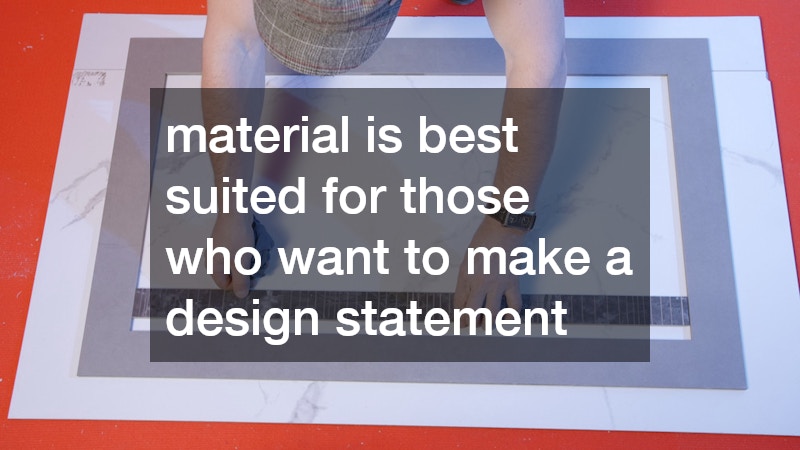When planning a bathroom remodeling project, one of the most important decisions you’ll make is selecting the right materials. From moisture resistance to durability and design flexibility, the materials you choose will impact the long-term function and aesthetic appeal of your bathroom. Given the unique challenges of this space—constant humidity, temperature fluctuations, and heavy use—your choices should prioritize both performance and visual harmony.
Here’s a breakdown of the best materials to consider for a bathroom remodeling project, from floors to walls to fixtures.
1. Tile: A Classic Choice for Flooring and Walls
Porcelain and Ceramic Tile
These materials are among the most popular for bathroom remodeling, and for good reason. Porcelain and ceramic tiles are water-resistant, easy to clean, and available in countless styles, textures, and finishes.
Porcelain, in particular, is denser and less porous than ceramic, making it ideal for floors and shower walls where water exposure is frequent.
Natural Stone Tile
Options like marble, granite, and slate provide a high-end, luxurious look. While they offer unmatched elegance, they do require sealing and more maintenance than porcelain or ceramic. Natural stone works beautifully for accent walls or vanity backsplashes when used thoughtfully.
2. Vinyl: Durable and Water-Resistant
Luxury vinyl tile (LVT) and luxury vinyl plank (LVP) are excellent options for homeowners who want the look of wood or stone without worrying about water damage. These materials are waterproof, easy to install, and comfortable underfoot. Modern vinyl products also feature realistic textures and patterns, giving you plenty of design flexibility.
Vinyl is especially well-suited for flooring, but it can also be used on walls or as a creative backsplash material in moisture-prone areas.
3. Quartz: A Top Performer for Countertops
Quartz is a non-porous engineered stone that resists staining, bacteria, and moisture—making it one of the best countertop materials for bathroom remodeling. Unlike natural stone, quartz doesn’t require sealing, and it’s available in a wide range of colors and patterns, some of which mimic the look of granite or marble.
Its consistency and durability make it a standout choice for bathroom vanities and integrated sinks.
4. Glass: Light, Clean, and Stylish
Glass is a versatile material used in shower enclosures, shelving, and tile accents. Frameless glass shower doors are a sleek option that can make small bathrooms feel more open. Glass tile, used as a backsplash or accent wall, adds a reflective quality that enhances natural light and creates a spa-like environment.
Glass surfaces are also easy to clean and maintain, making them a practical option for high-traffic bathrooms.
5. Solid Surface Materials: Seamless and Hygienic
Solid surface materials such as Corian offer seamless installation and integrated sinks, reducing crevices where mold and mildew can grow. These materials are resistant to stains and easy to repair if scratched or damaged. With a wide variety of color options and finishes, solid surfaces suit both modern and traditional bathroom styles.
They’re ideal for countertops and custom-built vanity tops, especially in homes where hygiene and ease of maintenance are a priority.
6. Paint: Moisture-Resistant Finishes Matter
When painting bathroom walls or ceilings, it’s critical to choose paint with a mildew-resistant formula and a semi-gloss or satin finish. These finishes are easier to wipe down and less likely to absorb moisture. Some specialty paints also offer mold-resistant additives, making them ideal for damp spaces.
Neutral tones, warm whites, and soft greys are popular choices that create a calming ambiance, while bold colors can add personality to accent walls or cabinets.
7. Wood: Use Carefully in the Right Places
Though not always considered a go-to for bathrooms, wood can be used effectively in certain areas—like vanities, cabinetry, and decorative beams—when properly sealed and maintained. Engineered wood or specially treated hardwoods like teak are better suited for humid environments.
Wood adds warmth and texture to a bathroom remodeling project and pairs beautifully with natural stone or tile for a balanced look.
8. Stainless Steel and Brass: Durable Metal Fixtures
For hardware, faucets, and showerheads, materials like stainless steel and brass stand out for their corrosion resistance and timeless style. Stainless steel is sleek and modern, while brass provides a warm, vintage appeal. Both materials resist tarnishing and withstand daily wear, making them ideal for bathrooms.
Additionally, these metals are often used for towel bars, handles, and other accessories, ensuring a cohesive, polished look throughout the space.
9. Concrete: Bold and Contemporary
Concrete is gaining popularity for sinks, countertops, and even flooring in modern bathroom designs. It’s durable, customizable, and offers a raw, industrial aesthetic that works well with minimalist or rustic themes. When sealed properly, concrete is water-resistant and long-lasting.
This material is best suited for those who want to make a design statement while maintaining function.
When it comes to bathroom remodeling, selecting the right materials is key to achieving a space that’s both beautiful and built to last. Consider how each element—from flooring to fixtures—will interact with moisture, heat, and daily use. Whether your style leans modern, traditional, or somewhere in between, the right combination of materials will elevate your bathroom and improve its longevity.
Prioritizing durability, ease of maintenance, and design cohesion will help you make confident choices that transform your bathroom into a sanctuary for years to come.



